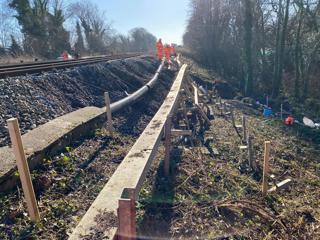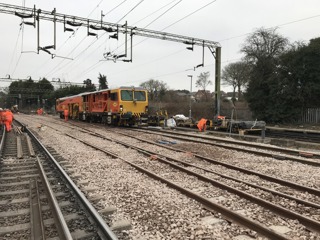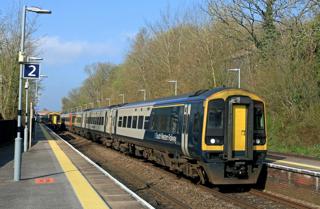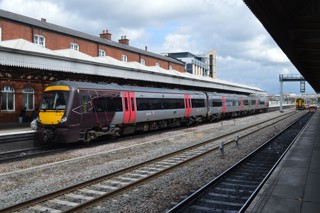Only ten seconds and a good dose of luck prevented a 70mph head-on crash between a Loram rail-grinding machine and a nine-car Class 222 Meridian on the Midland Main Line.
In circumstances almost identical to the fatal Southall crash in 1997, a Signal Passed at Danger (SPAD) brought a train ‘on the main’ into direct conflict with another using a crossover.
Publishing its report into the May 5 2021 ‘near miss’ at Sileby Junction (Leicestershire), the Rail Accident Investigation Branch (RAIB) revealed that the Colas Rail UK driver of the five-vehicle rail grinder failed to respond to a red signal, passing it at 40mph.
This triggered the Train Protection and Warning System (TPWS), which applied the emergency brake. But due to the machine’s low braking force, it overran the signal by 340 metres, coming to a stand fouling the crossover. The ‘conflict point’ is 272 metres from signal LR477.
Barely ten seconds earlier, the empty East Midlands Railway ‘222’ had passed over the crossover. RAIB reports that had the rails been damp, or the grinder been travelling at its 55mph maximum speed, it is likely that a collision with a closing speed of around 70mph would have occurred.
TPWS, introduced after the Southall and Ladbroke Grove crashes, is not designed to stop a SPAD, but to prevent it from becoming a collision.
In this case, the TPWS’ loop location was incorrect for the lower brake force of the grinder. TPWS assumes a braking rate of 12%g for passenger or 7.5%g for freight.
The rail grinder’s lower braking rate of 4.9%g was better than Network Rail’s minimum standard for track machines (4.6%g), but at its 55mph top speed TPWS would not prevent a collision at the location.
Network Rail’s TPWS effectiveness calculations do not account for trains with lower braking rates than 7.5%g.
The investigation discovered that the TPWS for signal LR477 (which had never been passed at danger before) was “not fully effective even for freight trains… at 60mph”.
The driver could not explain the SPAD, but RAIB determined that fatigue was a “probable underlying factor”. It was the driver’s sixth consecutive night shift.
He had started his shift at 2150 and drove the machine from the Chaddesden site (Derby) to the work site (35 minutes) at Kilby Bridge (south of Leicester). While Loram staff operated the machine, he spent around three and a half hours in the machine’s ‘convenience car’ behind the driving cab.
This has chairs, tables, and basic refreshment facilities, for use by train crew when they are not operating the train. During this time, he did not nap nor have anything to eat, but browsed social media and watched television shows on his mobile devices.
At 0343, the driver returned to the cab and drove to Wigston South Junction, where the possession was given up. The train departed for its return to Chaddesden at 0511. The SPAD occurred at 0529.
RAIB discovered that Colas was not aware that the experienced driver had been dismissed by EWS in March 2013, after a SPAD on November 26 2012 when his train collided with the gates of Morton level crossing (near Nottingham).
The driver joined Balfour Beatty in February 2014, transferring to Colas in July 2015 when it took over the rail grinding contract.
Although his training and competence records were transferred to Colas, it was not aware of the 2012 SPAD and dismissal. As the Balfour Beatty records were destroyed after the five years following his employment, it is not known whether Balfour Beatty was aware of his dismissal by EWS.
The driver left Colas after the incident and before a medical could be carried out, but he denied suffering from sleep apnoea.
Making two recommendations, RAIB says Colas should update its fatigue risk-management and that Network Rail should implement a process on the overrun risk for track machines and some freight trains, which have lower braking rates than those assumed when assessing the effectiveness of TPWS.

















Login to comment
Comments
No comments have been made yet.